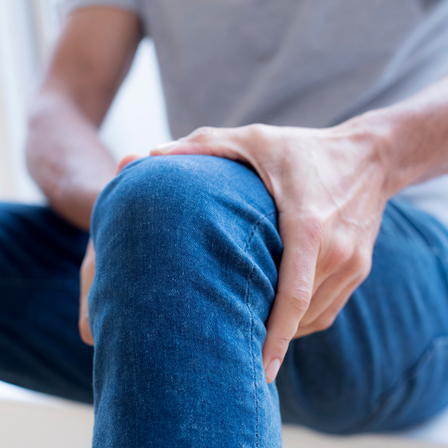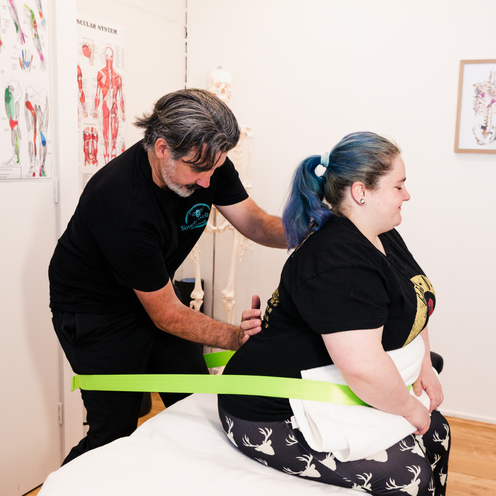|
By Peter Pascalis, Clinical Myotherapist When joints become stiff and sore we can be very aware of them. Standing from a chair can make us feel like we've aged 30 years. It can feel hard to do the most basic of things, like just straightening or bending your knee or elbow. We can feel a sharp jabbing sensation somewhere in our neck, our back, or any other affected joint. Joint dysfunction can alter muscle patterns, often creating compensations which cause further stress on neighbouring tissues, and changes to our ability to sense our body in space. So what can we do about it? In order for joints to move nicely on each other a certain degree of motion must be available or we end up with faulty motion and the potential for pain, inflammation, scar tissue, and overly worked soft tissue. The assessment of these joint movements requires the clinician to observe active and passive range of motion (termed as physiological and accessory motion) which are the small movements we cannot consciously control but which must exist to ensure the congruency and optimal function of joint surfaces. A reduction in joint glide or slide can cause dysfunction of the musculoskeletal system often leading to pain and stiffness, not to mention more serious pathology like a disc herniation and chronic pain may be a result of ongoing joint issues. In our clinical experience it is common to find these faulty joints often termed as hypomobile, meaning that they move less than other joints above or below them. Hypomobility will increase the tension on adjacent joints making the inert tissues such as ligaments prone to stretch. This micro trauma can initiate an inflammatory response with scarring of tissue and further reduction of movement and pain. Due to the close proximity of spinal nerves, muscles and body systems can be affected often with increases in painful areas. Mobilisations are graded in 4 stages which correspond to the amount of movement and force applied by the treating practitioner. The assessment of movement and pain precedes an informed decision to mobilise joints and this must be agreed to by the client. Grades 1 & 2 are used to reduce pain and grades 3 & 4 to increase mobility. Is a mobilisation the same as when a Chiropractor cracks your joints? What sets mobilisations apart from high velocity thrust manipulations (the 'cracking" of the joints) is that manipulations are produced by progressing beyond the physiological limit of a joint range whereas all 4 grades of mobilisation are within the range of the joint. This is why a pop is heard during a Chiropractic manipulation, which is the release of gases from the joint surface. Both mobilisation and manipulation have similar physiological effects on joint movement and soft tissue responses and are carried out by professionally trained clinicians. As Myotherapists we are trained and insured to perform all 4 grades of mobilisations. Joint mobilisation can reduce sensitivity to painful stimuli and changes to the sympathetic nervous system. For a more in depth understanding of the physiological and neurological effects of joint mobilisations please refer to the blog titled I’m In Pain: How Can Myotherapy Help? When pain reduction and improvements of movement have been achieved another technique called Mobilisation With Movement (MWM) developed by Physiotherapist Brian Mulligan can further create pain free movement in the most restricted movement, meaning that the movement which causes restriction can be directly targeted with accessory glides whilst the patient performs the action. These are generally pain free and improvements can be seen instantaneously. The benefits of such a treatment is that patients can see and feel the immediate improvements in range and further progress can be achieved with sports taping to support the new range. Although mobilisations and mobilisations with movement are preferably performed on skin these techniques can certainly be effective for patients that prefer to be fully clothed for their treatment. The treatment belt is used for stabilisation during treatment and to mobilise the patient while movement occurs. As mentioned earlier a thorough assessment is performed to identify the hypomobile joints however sometimes we can also find joints that are moving more than would be ideal - these are termed hypermobile joints.
Hypermobile joints have the opposite problem, they have too much freedom to move and this can cause muscular pain as your muscles work overtime to stabilise the joint. For this type of joint problem we would prescribe exercises rather than increasing mobility at an already hypermobile joint. Mobilisations and MWM’s are a couple of wonderful treatment techniques underpinned by extensive research and clinical efficacy which are used to improve pain and function. Book with me for a thorough assessment and treatment plan for your joint pain, whether its stiff achy hypomobile joints or sore fatigued and over worked muscles stabilising a hypermobile joint. I'm available Mondays, Wednesdays, Thursdays and Saturdays, and you can make an appointment with me online or phone the clinic on 03 8204 0970 to book in. |
Meet Our Team
We have a team of great practitioners available 7 days a week at our Rowville clinic. Archives
July 2024
Categories
All
|
Got a question about Myotherapy?
Contact Mel by phone, email or Facebook
|
Simple Wellness Myotherapy & Remedial Massage Clinic
Shop 12B 150 Kelletts Rd Rowville VIC 3178 |
Phone us on
03 8204 0970 |



 RSS Feed
RSS Feed